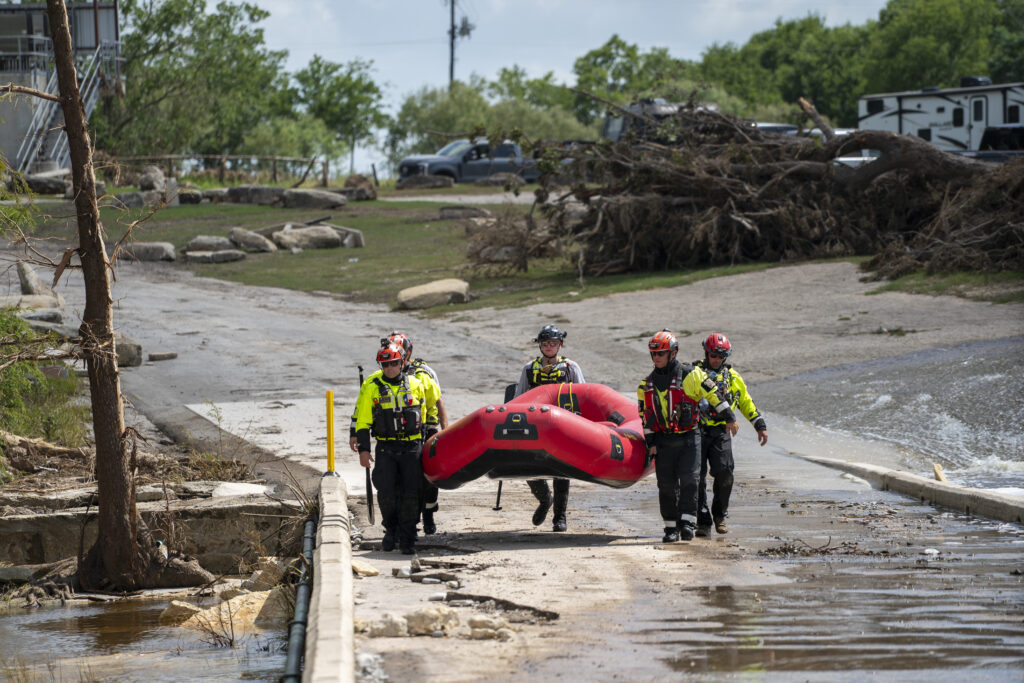The death toll from the July 4 flash floods in central Texas—at least 136 dead, including thirty-seven children—is a failure of strategic resilience that should concern all Americans. Flash floods are not unique to central Texas. Flash floods killed an average of 113 people a year over the past ten years, based on National Weather Service statistics. Hurricanes, by contrast, kill an average of twenty-seven; tornadoes forty-eight. Only extreme heat is a more deadly natural disaster, with an average of 238 in the past decade.
The Atlantic Council’s resilience task force defines resilience as the ability of individuals, societies, and systems to anticipate, withstand, recover from, adapt to, and bounce forward from shocks and disruptions. Strategic resilience, when it works, leverages the powers of governments at all levels and the private sector to strengthen individual and community resilience.
What happened in Texas was a strategic failure at all levels to protect thousands of residents and visitors, including eight-year-old campers, in a river valley known to federal, state, and local weather and emergency managers as “Flash Flood Alley” and “one of the three most dangerous regions in the U.S.A. for flash floods.”
After July 4, federal, state, and local officials tried to avoid or deflect responsibility, or claim this flash flood was unforeseeable, but the truth is that all levels of government hold some measure of blame for this catastrophe. A series of tactical blunders added up to a strategic failure. Some examples:
- After a deadly flood downstream in 2015, local officials in Kerr County decided a one-million-dollar emergency warning system that included flood gauges and sirens was too expensive.
- Local officials later applied to the Texas Division of Emergency Management, which controlled billions of dollars of Federal Emergency Management Agency (FEMA) money. They were turned down because the county had not written a hazard mitigation plan. By the time the county wrote one, Texas prioritized other counties devastated by Hurricane Harvey.
- In 2021, Kerr County could have used $10.2 million from the American Rescue Plan Act signed by President Joe Biden, but the county spent a lot of the money on other projects (including a communications system for the sheriff’s office that helped during the flood).
- Earlier this year, Texas lawmakers proposed giving local governments $500 million to upgrade emergency communications systems, but the bill died in a Texas Senate committee.
- On July 4, the first flash flood warning from the National Weather Service (NWS) was at 1:15 a.m. The NWS computer model used available data but considerably underestimated the amount of rain. Other models were more accurate. The Trump administration’s cuts to NWS data collection programs may have affected the NWS’s ability to issue an earlier, or more accurate, warning—which could have saved lives at Camp Mystic.
- A forecast of life-threatening weather not communicated to the people who need to act on it is, by definition, a system failure. The Trump administration’s layoffs and early retirements at NWS included the one official whose formal responsibility was to communicate with state and local officials when warnings are issued. Inadequate outreach to local officials and the public may have contributed to the death toll.
- With no sirens or flood gauges, the regional emergency system relied on cell phones to alert people—but many officials and residents claim they never got those alerts on July 4, and children and even counselors at Camp Mystic did not have their cell phones at night.
- Kerr County officials chose not to use its emergency notification system, the Integrated Public Alert & Warning System, that could have activated every cell phone in the valley into an alarm.
- Instead of FEMA’s traditional practice of surging resources like urban search and rescue teams to look for survivors—which, under earlier administrations, would likely have arrived in Kerr County by the evening of July 4—Department of Homeland Security (DHS) Secretary Kristi Noem’s requirement to personally approve all DHS contracts above $100,000 meant that crucial funding to deploy the teams was not authorized until July 7. The head of FEMA’s urban search and rescue team later resigned, telling colleagues that he was frustrated at the “bureaucratic hurdles” in the administration’s flood response.
- On July 6, FEMA laid off contractors whose job was to field phone calls. FEMA contractors answered 99.7 percent of the 3,027 calls on July 5, but only 35.8 percent of 2,363 calls on July 6 and a meager 15.9 percent of 16,419 calls on July 7.
- FEMA had fewer than a hundred people on the ground four days after the floods in Texas, whereas a week after Hurricane Helene under the Biden administration, FEMA had more than 1,500.
Before the next flash flood in Texas … or elsewhere in the US
Other states, and Washington, need to learn the lessons of the central Texas flash floods. There are some straightforward fixes: River flash flood alarms are essential in vulnerable populated areas. Cell phone alerts need to be tested the way schools test fire alarms—if you can’t hear the fire alarm, the school should install more alarms. If cell phone networks are the main alarm system, then local officials need to insist on better cell phone coverage as a public safety requirement.
But other needed changes will be more complex. Preventing future Camp Mystics will require sustained focus—and resources—from federal, state, and local governments—as flash floods this summer have hit everywhere including New Jersey, Illinois, North Carolina, and New Mexico.
Here are some steps to take now:
1. Change the mindset—and the money—for strategic resilience. A more strategic approach to resilience would have led to different priorities for funding and responding before and during flash floods. A larger shift is needed in how both individuals and governments understand and prepare for resilience. Just as Texas and other Gulf Coast states take the threat of hurricanes seriously, Texas and other parts of the country must ensure that communities view flash floods with a similar level of seriousness and resolve. Acting FEMA administrator David Richardson said on July 23, “Resilience is a priority for me, and it’s a priority for FEMA.” These words need to be backed up by action—and money. More money is essential to prevent the future loss of life and property damage from flash floods. Studies have shown that disaster prevention has an extraordinary return on investment. A US Chamber of Commerce 2024 study on weather-related disasters calculated that each dollar spent in disaster preparedness saves thirteen dollars in costs reduced, damages avoided, and cleanup made unnecessary. Thinking of the children in Texas whose lives could have been saved by an earlier flash flood warning, the non-financial return on investment is incalculable.
2. Don’t place more of the burden of disaster recovery on states, because states will not be ready for three years—if ever. The Trump administration has said it wants to make FEMA more responsive to state and local needs, which sounds like the administration is unaware of FEMA’s longtime mantra that disaster recovery should be locally led, state-managed, and federally supported. If the goal is streamlining aid and making FEMA more flexible, much can be done to improve what FEMA does, and this will have broad support. However, emergency managers fear the administration’s real intention is to shift more of the financial and personnel burden of recovery to the states, which are already reeling from billions of dollars of cuts to Medicaid, supplemental nutrition, and other vital programs. Most states have to balance their budgets, and few can borrow money after a disaster as cheaply as the federal government can. Because of how state budgets are developed, it will take most states three years, at least, to decide whether to increase taxes—or tell communities there will be no money to rebuild. This will hurt all Americans, especially in southeastern states that voted for Trump in 2024. Until and unless states are ready, the Trump administration should fund FEMA, hire the employees and contractors FEMA needs, and eliminate red tape that slows FEMA down.
3. Open an honest, impartial, nonpartisan investigation into the Texas floods. As soon as practicable, there needs to be a credible, national-level, nonpartisan, no-fear-or-favor investigation into what went wrong. There is bipartisan Senate legislation to set up a disaster safety board modeled on the National Transportation Safety Board (NTSB), but with the House adjourned, other credible bodies should urgently set up an ad hoc, nonpartisan investigation led by experts in weather forecasting, emergency management, and hazard mitigation.
4. Restore and fund the Building Resilient Infrastructure and Communities (BRIC) program. BRIC was intended by the first Trump administration and Congress in 2018 to get billions of dollars to state and local governments for precisely the kind of investments needed to warn of flash floods and reduce losses during other disasters. But the Trump administration killed the program in April, canceling $882 million in already appropriated money and drawing a lawsuit from twenty states. The Trump administration should quickly settle the lawsuit, and Congress should follow the lead of Republicans on the House Appropriations Committee who voted to revive BRIC and make it a mandatory program that DHS cannot abolish or de-fund on its own.
5. Establish a Joint Congressional Resilience Caucus. Disaster response and recovery is complex and, to the public, often confusing. Within DHS, FEMA has the lead, but in Texas both the Coast Guard and Customs and Border Protection had life-saving roles. For long-term recovery, the Departments of Housing and Urban Development and Defense, especially the Army Corps of Engineers, are essential. Congressional oversight of DHS is divided among eleven different committees in the House and nine in the Senate. In 2023, House Democrats established the Disaster Equity and Building Resilience Caucus. Congress needs to establish a bipartisan caucus to promote and increase strategic resilience across the federal government and to advocate for what states need.
6. Commit to making disaster recovery bipartisan. Trump and other Republicans criticized FEMA under Biden for slowness in responding to Hurricane Helene. While many of those complaints were false or unjustified, even former FEMA leaders agree FEMA could improve how it responds. FEMA is good at getting initial cash quickly into disaster victims’ hands, but then sometimes takes years to close out projects. Many of the delays, ironically, are caused by congressional mandates or the desire to avoid taking actions without approval from political appointees. Reducing red tape and avoiding requirements to spend money in unproductive ways needs bipartisan support. The administration and Congress should commit to making disaster response and recovery a bipartisan effort. The just-released bipartisan Fixing Emergency Management for Americans Act of 2025 is an important step that needs serious consideration. The Trump administration should endorse it and work with its sponsors, state and local emergency managers, and congressional appropriators to make reforms with bipartisan support.
Strategic resilience needs to become a national priority before the next disaster. US leaders owe as much to the adults and especially the children who died in central Texas on July 4.
Thomas S. Warrick is a nonresident senior fellow with the Adrienne Arsht National Security Resilience Initiative in the Scowcroft Center for Strategy and Security. He previously served for more than a decade in the Department of Homeland Security.
Further reading
Tue, Jul 8, 2025
For the US and the free world, security demands a resilience-first approach
Report By Elizabeth Sizeland
This report is the foundational document of the Adrienne Arsht National Security Resilience Initiative and outlines a bold vision to embed resilience as a core pillar of US and allied security. As crises compound, this report calls for investing across individual, institutional, and international levels of resilience to withstand, adapt, and thrive amid disruption.
Wed, May 7, 2025
Lessons from Latvia’s efforts to keep essential services running during a crisis
New Atlanticist By
Latvia has shifted its crisis-management thinking from a focus on infrastructure protection to an emphasis on continuity of essential services and functions.
Thu, Apr 24, 2025
Defending Taiwan means mobilizing society, not just the military
Issue Brief By Marvin J. Park
Taiwan is under unprecedented pressure from the People’s Republic of China (PRC), facing coordinated threats on multiple fronts.
Image: July 10, 2025, Center Point, Texas, United States of America: A Texas State water search and rescue team based in San Antonio portages their boat around a dam near Center Point. The team has been searching for remains of people still missing following the July 4-7, 2025, flash flooding in Kerr County. (Credit Image: © Gregg Brekke/ZUMA Press Wire)




